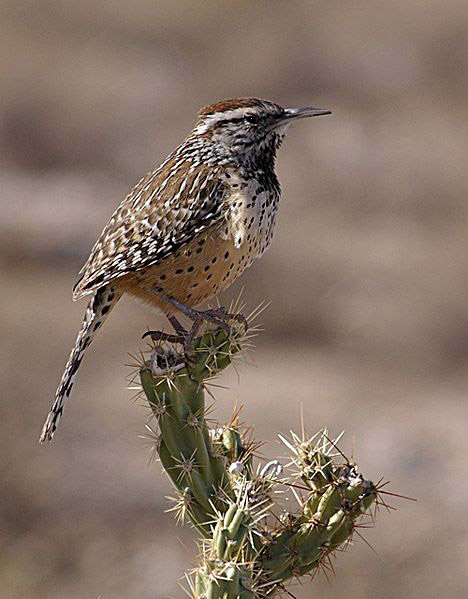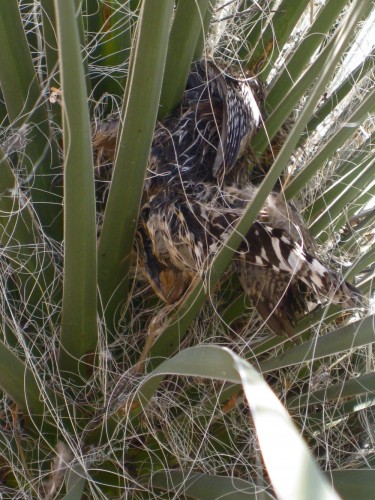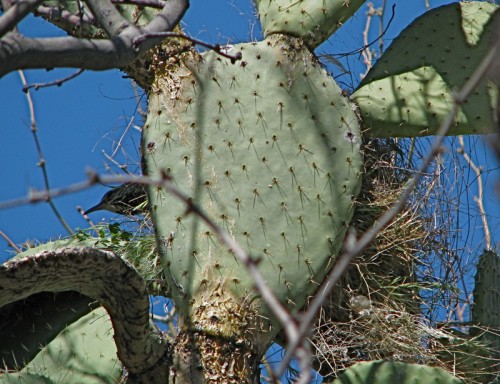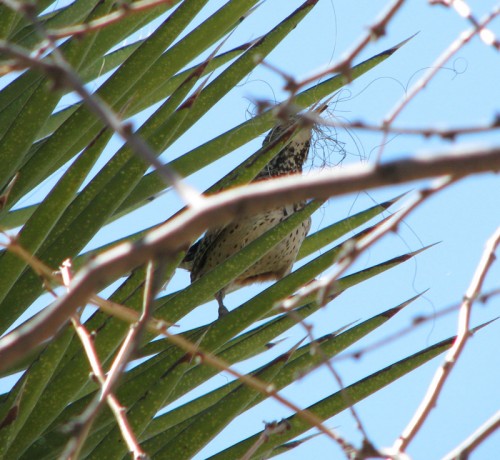The Curious Case of the Corpse in the Yucca
 Cactus wrens are a large (for a wren), lively, and common presence all over the low-elevation deserts in the American Southwest. The photo to left left shows one sitting on a cholla branch. They do that a lot, often while making all sorts of mechanical-sounding vocalizations like drbrdrbrdrbrdrr or krakrakrakrakrakra. Cactus wrens are expert at landing on, perching on, and building in fiercely prickly vegetation, usually constructing their unruly globular “kitchen sink” nests weaving fiber, litter, twigs and plastic safely into the protective arms of seriously spiny cactus species like cholla.
Cactus wrens are a large (for a wren), lively, and common presence all over the low-elevation deserts in the American Southwest. The photo to left left shows one sitting on a cholla branch. They do that a lot, often while making all sorts of mechanical-sounding vocalizations like drbrdrbrdrbrdrr or krakrakrakrakrakra. Cactus wrens are expert at landing on, perching on, and building in fiercely prickly vegetation, usually constructing their unruly globular “kitchen sink” nests weaving fiber, litter, twigs and plastic safely into the protective arms of seriously spiny cactus species like cholla.
Last week we found a Cactus wren dead in our yard, stuck in the leaves of a yucca. Here’s a photo I took of it (take my word for it, the spotty plumage is diagnostic):
This was certainly sad, but it also seemed very odd. We couldn’t tell how the bird died, but there it was, a sorry speckled-feathery carcass wedged in the leaves of a Soaptree yucca. Was it stashed there by a predator? Not likely; there are predators that do that, but they don’t frequent our yard. Did it die in the foliage above and fall there? That doesn’t seem likely, either — it was wedged in tight, and somewhat horizontally. Did it get stuck there, somehow, maybe a foot caught in the narrow leaves? Possibly.
Here’s another wren story, not sad and perhaps enlightening.
Just a few days after the macabre yard find, E and I visited Boyce Thompson Arboretum, and paused on our walk for a few moments to watch a pair of Cactus wrens (Campylorhyncus brunneicapillus) busily working on a nest in the upper branches of a tree Prickly pear, a really tall variety of Opuntia.  You can see the main support pad in the photo on the left, with the fibrous nesting material sticking out to the right, and the streaky bird’s head poking out to the left. The wren was about to launch itself into the next plant over, a Soaptree yucca, to continue rummaging between the rigid leaves to gather tough hair-like fibers (visible especially clearly in the carcass photo above) that grow along the yucca stem at the bases of the leaves. It did this over and over again, each time going deep into the spiky growth to tug and pull at the free building material to use in its nest. Below is the best photo we managed of the wren reappearing with its beak full of yucca fibers. Considering the tough and pointy nature of the vegetation as well as the close quarters, it looked like hazardous work, although poking around in nooks and crannies, probing with their narrow, strong beak, is what cactus wrens are built to do. (I’ve tried to extract unwanted volunteers like fan palm sproutlings and African sumac seedlings from inside yucca clumps, and let me say that gloves, eye protection and long sleeves are often not up to the task.)
You can see the main support pad in the photo on the left, with the fibrous nesting material sticking out to the right, and the streaky bird’s head poking out to the left. The wren was about to launch itself into the next plant over, a Soaptree yucca, to continue rummaging between the rigid leaves to gather tough hair-like fibers (visible especially clearly in the carcass photo above) that grow along the yucca stem at the bases of the leaves. It did this over and over again, each time going deep into the spiky growth to tug and pull at the free building material to use in its nest. Below is the best photo we managed of the wren reappearing with its beak full of yucca fibers. Considering the tough and pointy nature of the vegetation as well as the close quarters, it looked like hazardous work, although poking around in nooks and crannies, probing with their narrow, strong beak, is what cactus wrens are built to do. (I’ve tried to extract unwanted volunteers like fan palm sproutlings and African sumac seedlings from inside yucca clumps, and let me say that gloves, eye protection and long sleeves are often not up to the task.)
So did our hapless yard wren get caught somehow while carrying out this dangerous domestic mission? We can never know for sure, but it seems in the realm of possibility. It’s hard out there for a bird.
(Top photo, from Wikimedia Commons, by Mark Wagner. Other photos by A&E Shock)
Another dire tale of cactus wren-related nesting mishap casts the spectre of botanical revenge on this story: a couple of years ago, the continuous plucking of fiber off of a hairy “Old Man” cactus in the yard by a diligently nesting Cactus wren denuded the plant’s crown so much it experienced horrible sun-burn, and died.

